The history of Seiko watches begins in 1881
Searching for perfection
The Story of SEIKO Began in 1881 when a 22-year-old entrepreneur Kintaro Hattori Opens its clocks repair shop in Tokyo. He was determined to become the pioneer of the watch industry and put a point of honor at what " SEIKO always had a step ahead of the others ". 11 years later, in 1892, he founded the factory" Seikosha " And made his first clock and in 1895, his first watch. SEIKO has never given its place as a leader in technological innovation, the real secret of its success.
With this great expertise, SEIKO has created synergies between the different technologies that have led to great innovations. SEIKO is currently a real " Manufacture " Manufacturing its own components, of the circuit integrated into the spring spiral, and it is the only manufacture mastering four watchmaking technologies: mechanical, quartz, Kinetic and Spring Drive. Today, after 132 years of innovation, the watchmaking factory remains faithful to the commitment of its founder: the quest for perfection.
The strength of synergies
The synergy bases SEIKO's commitment of excellence.
56 years after the realization of his first mechanical wristwatch, SEIKO inves the quartz watch. The alliance of tradition and electronics opens up new paths. The era of quartz is barely born that the engineers are already dreaming of the next stage: the Kinetic watch. 19 years later, this dream becomes reality. KINETIC is the first time in the world to produce its own electricity. A rotor actuated by the wrist movement will feed the quartz movement. The innovative spirit of SEIKO then thinks of the realization of another dream: a spring watch with the highest level of precision. The quartz had given rise to Kinetic, creating Spring Drive.
Today, SEIKO is committed to new horological adventures and will build on the synergy of the four main technologies for the next revolutionary discoveries.
The 1Ers Global
1913
In 1913, Seiko produced the " Laurel ", the first mechanical wristwatch made in Japan.
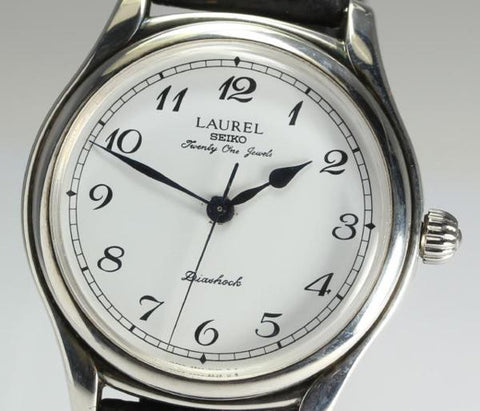
1941
In 1941, Seiko launched his pocket chronograph.
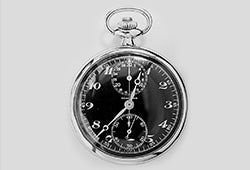
1969
Seiko Astron, world's first quartz watch
Seiko is the first to market an automatic chronograph watch that has both a vertical clutch and a column wheel. The company markets and launches its first quartz watch, the " Seiko quartz Astron ".
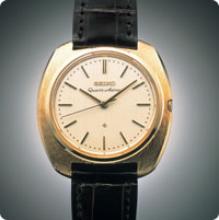
1973
First quartz watch world with 6-digit LCD digital display
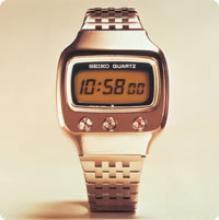
1975
First multifunction digital watch in the world
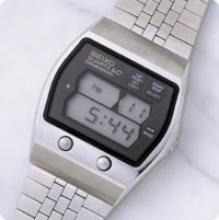
1982
First watch in the world that can receive television
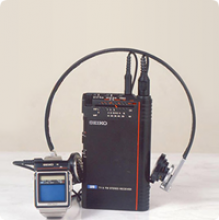
1983
First watch in the world capable of recording sounds
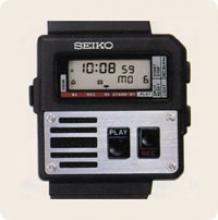
1984
First computer watch in the world

1988
Launch of the first shows A. G. S "Kinetic". The first intelligent analog quartz watch in the world.
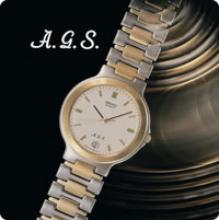
1990
Seiko presents the world's first diving watch with a diver's 'Scubamaster'.

1998
Seiko created the world's first thermoelectric watch and offers a watch with a perpetual calendar.
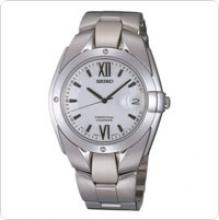
1999
Seiko introduces first movement " Spring Drive " Which has a precision of one second per day.
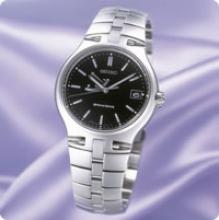
2005
Creation of the world's first watch driven by triband radio waves

2006
Seiko invers the world's first electronic ink display:INK, G510 caliber.
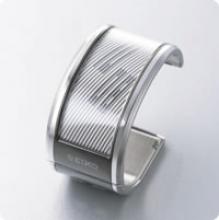
2007
SpringDrive, the world's first chronograph to measure the elapsed time using a sliding motion
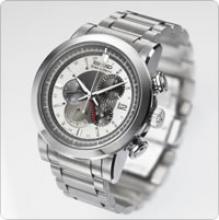
2008
First watch in the world specifically designed for space outings
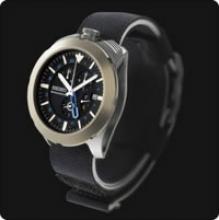
2010
The EPD: the world's first active-matrix electrophoresis display
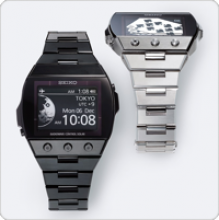
2012
Launch of the first GPS watch Analog in the world
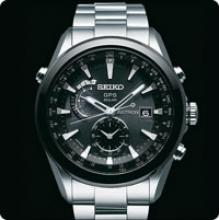
2013
100th anniversary of the first SEIKO wristwatch

2014
Seiko wins the " Little Aiguille Prize 2014 Grand Prix d' Horlogerie de Genève.
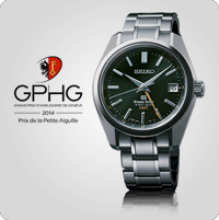
Seiko movements

Automatic Chronograph
Calibre
8R48
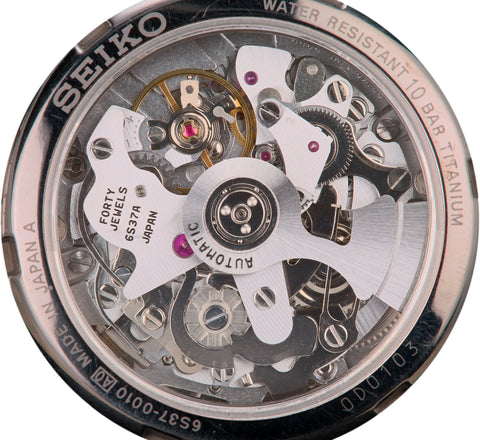
This automatic chronograph movement has 292 pieces and 34 rubies combining perfectly the mechanical clock tradition and the high precision chronograph function.
Technical Information
Frequency: 28800 alt. /hr
Number of rooms: 292
Rubis: 34
Movement of movement diameter 28.6 mm, height 7.2 mm
Anchor scale
Shock Balancer
45-hour reserve self-reserve
Auto-Armor by ratchet
Manual Armor by the Crown
Timesograph function up to 12 hours
30 minutes minutes counter
12-hour hours counter
Instant Zero Discount by 3-sided Hammer
Control of column sternwheelers and vertical clutch of the chronograph function
Move from date to snapshot.
Automatic
Calibres
6R15, 6R21, 6R27
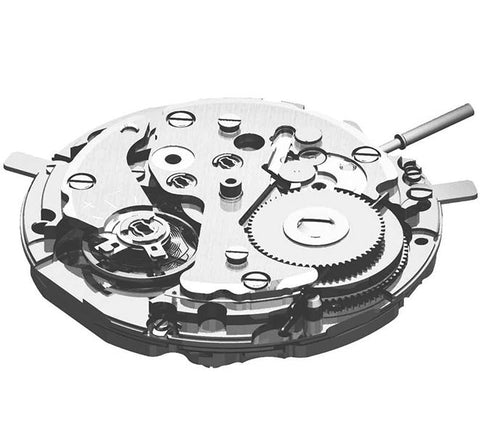
This automatic calibre was launched in 2007. Its frequency of regulation is 21 600 alternations per hour. It consists of 168 rooms including 23 rubies. It has a manual reassembly function. The finish of the mass is in Côtes de Genève.
Its walking reserve is 50 hours thanks to the spring made in Spron 510 *, new material patented by SEIKO and from Spring Drive technology.
Technical Information
Frequency: 21600 alt ./h.
Number of rooms: 168
Rubis: 23
Movement of movement diameter 27.4 mm, height 5.25 mm
Anchor scale
Shock Balancer
50-Hour Walking Reserve Autonomy
Spron Engine Spring 510 *
Auto-Armor by ratchet
Manual Armor by the Crown
Mass of automatism in the Côtes de Genève
3 needles: hour, minute, and second
Specifying the date by machine
Quick Fix of Date
End of second function.
* Trademark of Seiko Instruments INC.
Automatic Dual Retrograde
Calibre
6R24
This automatic caliber was launched by SEIKO in 2009. Its frequency of regulation is 28800 alternations per hour. It consists of 224 parts including 31 rubies. It has a walking reserve indicator as well as a manual reassembly function.
Its walking reserve is 45 hours thanks to the spring made in Spron 510 *, new material patented by SEIKO and from Spring Drive technology.
Technical Information
Frequency: 28800 alt ./h.
Number of rooms: 224
Rubis: 31
Movement control: diameter 27.4 mm, height 6.0 mm
Anchor scale
Shock Balancer
45-hour reserve self-reserve
Spron Engine Spring 510 *
Auto-Armor by ratchet
Manual Armor by the Crown
3 needles: hour, minute, and second
Specify Date and Day by Needles
Quick Fix of Date and Day
End of second function
* Trademark of Seiko Instruments INC.
Automatic Central Walking Reserve Indicator
Calibre
4R57
This automatic gauge has a throttling frequency of 21600 alternations per hour. It has 29 rubies. It has a central walking reserve indicator as well as a manual reassembly function.
Its walking reserve is 41 hours thanks to the spring made in Spron 510 *, new material patented by SEIKO and from Spring Drive technology.
Technical Information
Frequency: 21600 alt ./h.
Rubis: 29
Movement control: diameter 42.0 mm
Anchor scale
Shock Balancer
41-hour walking reserve autonomy
Spron Engine Spring 510 *
Auto-Armor by ratchet
Manual Armor by the Crown
3 needles: hour, minute, and second
Specify Date by Needles
* Trademark of Seiko Instruments INC.
Automatic
Calibres
4R35, 4R36, 4R38, 4R39
This automatic gauge has a throttling frequency of 21600 alternations per hour. It has 24 rubies. It has a manual reassembly function.
Its walking reserve is 41 hours thanks to the spring made in Spron 510 *, new material patented by SEIKO and from Spring Drive technology.
Technical Information
Frequency: 21600 alt ./h.
Rubis: 24
Movement control: diameter 39.2 mm
Anchor scale
Shock Balancer
41-hour walking reserve autonomy
Spron Engine Spring 510 *
Auto-Armor by ratchet
Manual Armor by the Crown
3 needles: hour, minute, and second
* Trademark of Seiko Instruments INC.
Calibre
8L35
This caliber is the worthy heir of the calibres SEIKO G105 of the 70s and takes over the codes. It consists of 224 parts, including 26 rubies. It has a manual reassembly function. Its walking reserve is 50 hours thanks to the spring made in Spron 510 *, new material patented by SEIKO and from Spring Drive technology.
Technical Information
Frequency: 28800 alt ./h.
Number of rooms: 224
Rubis: 26
Movement control: diameter 27.4 mm, height 6.0 mm
Anchor scale
Shock Balancer
50-Hour Walking Reserve Autonomy
Spron Engine Spring 510 *
Auto-Armor by ratchet
Manual Armor by the Crown
3 needles: hour, minute, and second
Specify Date and Day by Needles
Quick Fix of Date and Day
End of second function
* Trademark of Seiko Instruments INC.
Quartz Solaire
Calibres
8B92, V158, V172, V176, V195
The solar watches are quartz watches which do not have a battery but are solar collectors on the dial and an energy accumulator system.
Since the invention of the quartz watch in 1969, SEIKO has become a leader in the watchmaking industry. Today, SEIKO offers a complete collection of quartz watches powered by the energy of light, including solar alarms chronographs and solar dials.
Capable of converting any light source to energy and without change of battery *, SEIKO solar is a brilliant idea to preserve the environment.
*The electricity generated by the solar cell is stored in a rechargeable battery.
Unlike all other batteries, it provides the energy needed for your watch for a longer life, without a change of battery. This technology is practical and environmentally friendly.
Kinetic
Calibres
5M62, 5M63, 5M65, 5M85
The name Kinetic was inspired by the Greek word " Kinesis " Meaning " Movement."
The SEIKO Kinetic watches are quartz watches without a pile having an integrated electricity generator system. This generator works thanks to the movement of the arm; its rotation can range from 10 000 to 100 000 turns per minute.
The KINETIC technology, patented by SEIKO started in 1988 under the name " A.G.S. " (Automatic Generating System); it has been named after Kinetic since 1992. The autonomy of these models can last up to 4 years (for Auto-Relay models).
POPULATED BY YOUR MOVEMENTS
The first quartz watch in the world is barely out when SEIKO engineers embark on a new challenge: to invent a quartz watch that would generate its own energy. The key to technological success is to achieve maximum energy and minimize consumption. In 1988, with 50 patent filings, the goal was reached: SEIKO created the Kinetic watch.
POWER SUPPLY
The Kinetic miniature generator contains a rotor suspended by magnetic levitation. It can reach up to 100 000 rpm, or 5 times faster than a Formula 1 engine. The first Kinetic watch consumed only 0.9 microwatt of electricity, or 3 % of the energy required for the operation of the Astron Quartz. Today, the Kinetic Direct Drive consumes only 0.71 microwatt.
SOLAR GPS
Calibre
8x22
Technical Information
Adjust the time and time zone by GPS
Specify the reception of the signal
Acute hours, minutes, seconds
Function Needles
Date Window at 3:00 a.m.
Perpetual calendar adjusted until February 2100
Global time function (40 time zones, possible crown selection)
Daylight Saving Time/Winter (DST)
Energy saving function (from 72 hours without light source) up to 2 years maximum
Avion Mode
Demonstration mode
Operation: solar energy (feed by all types of light sources)
Precision:
+/ - 1 second every 100,000 years (with GPS signal received);
+/ - 15 seconds per month (not receiving GPS signal)
Energy reserve: 6 months (2 years in energy saving mode)
MULTI-INDICATIONS DIAL AT 9AM
- Satellite Receipt Indicator (1/4 +)
- Avion Mode
- DST ON/OFF (Daylight Savings Time/Winter Time)
AN INNOVATIVE, HIGH-SENSITIVITY ANNULAR ANTENNA
SEIKO invented an extremely sensitive annular antenna, housed in the upper part of the watch case. By placing the antenna under the inner lens of the dial, SEIKO has succeeded in increasing the receptivity to the maximum; a feature which is also improved by the ceramic refractor.
AN OPTIMIZED ENERGY ECONOMY
- Extremely low energy consumption (40 % lower than the 7X52 size). This energy saving makes it possible to reduce the size of the housing by 30 % in width and thickness.
- Lithium Ion Accumulator
INTUITIVE MANIPULATION
- Electronic adjustment of the time zone by the crown, offering a simplified use.
- Automatic reception of the data relating to the second intercalary (The second intercalary is defined by a time difference between the universal time (UT) which is determined astronomically, and the international atomic time (TAI) which is determined by the atomic clock).
VERY HIGH QUALITY MATERIALS
The enclosures
Inspired by the design of the satellites, the ASTRON boxes are made of high intensity titanium or stainless steel, polished by hand. They show no haste thanks to the implementation of the Zaratsu polishing method.
The bracelets
Most models are mounted on high intensity titanium bracelets which ensures a resistance equivalent to that of stainless steel while being 40 % lighter. Others are made of stainless steel or crocodile leather. All have a pull-button with a push-button.
The Glasses
The glasses are all in ceramic to optimize the reception of the satellite signals.
The glasses
The sapphire glasses are treated anti-reflection by the technology SUPER CLEAR-technology invented by SEIKO, thanks to a process of treatment of 2 faces of the glass, it allows to reduce to 1 % the reflected light and let pass 99 %.
Indexes
Very bright index or index markers that shine in the night, just like the planets in space.
Calibre
8x53
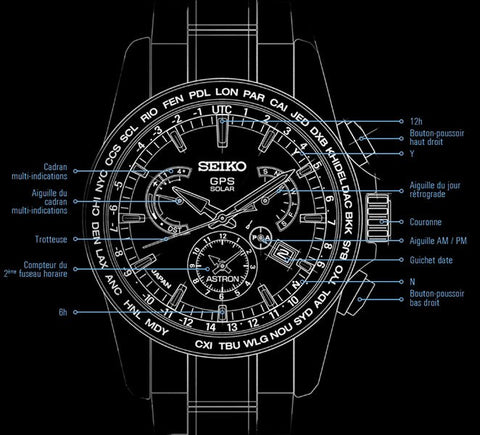
Technical Information
Adjust the time and time zone by GPS
Specify the reception of the signal
Dual time zone function with display on a dial at 6 o'clock (display of 2nd time zone on 12h and indication morning (AM)/afternoon (PM))
Acute hours, minutes, seconds
Double timezone needles located in a dial at 6 a.m.
Indicator needle 4 AM / PM
Retrograde daylight indicator pointer at 2h
Function pointer
4: 00 date window
Adjust the perpetual calendar to February 2100, showing the date and retrograde date
World time function (40 time zones - possible crown options)
Daylight saving time (DST) switching function
Energy saving function (72 hours without light source) up to 2 years
Aircraft mode
Demo mode
Operation: solar energy (powered by various light sources)
Accuracy:
+/-1 second every 100000 years (receiving GPS signal);
+/-15 seconds per month (no GPS signal received)
Energy reserve: 6 months (2 years under energy saving mode)
9:00 am multi indicator dial
- Satellite reception indicator (1 / 4 +)
- Operation standby indicator
- Aircraft mode
- DST on / off (summer / winter time)
A novel high sensitivity ring antenna
Seiko invented a very sensitive ring antenna, which is installed on the upper part of the watch case. By placing the antenna under the inner baffle of the dial, Seiko successfully improves its receiving capacity to the maximum; Ceramic baffles also enhance this feature.
Optimize energy saving
- Very low power consumption (40% lower than 7x52 aperture). This energy-saving measure reduces the width and thickness of the shell by 30%.
- Lithium ion battery
Intuitive operation
- Crown electronic time zone adjustment provides simplified use.
- Automatically receive the second interlayer data (the second interlayer is defined by the time difference between the astronomical determined world time (UT) and the International Atomic Time (TAI) determined by the atomic clock).
High quality materials
Shell
Inspired by the satellite design, astron's shell is made of high-strength titanium or stainless steel and polished by hand. Due to the implementation of zaratsu polishing method, they do not have any roughness.
Bracelet
Most models are mounted on high-strength titanium bracelets, providing the same strength as stainless steel, but 40% lighter. Others are stainless steel or crocodile skin. They all have an expansion ring with buttons.
glasses
These glasses are made of ceramic to optimize the reception of satellite signals.
glasses
Sapphire glass adopts the super transparent technology invented by Seiko for anti reflection treatment. Through the treatment of both sides of the glass, the reflected light is reduced to 1% and the transmittance reaches 99%.
Indexes: The bright colored index finger or index finger mark glows at night, just like a planet in space.
calipers
8x82
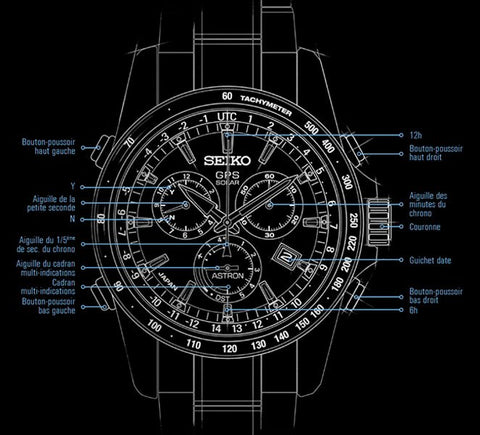
Technical information
Adjust time and time zone via GPS
Signal receiving indication
1 / 5 second timing, up to 6 hours
Reference tachometer: sse037j1, sse031j1, sse017j1, sse013j1
Needle hour, minute, second
Timer pointer
Function pointer
4: 00 date window
Perpetual calendar adjusted to February 2100
World time function (40 time zones - possible crown options)
Daylight saving time (DST) switching function
Energy saving function (72 hours without light source) up to 2 years
Aircraft mode
Demo mode
Operation: solar energy (feed by all types of light sources)
Precision:
+/ - 1 second every 100,000 years (with GPS signal received);
+/ - 15 seconds per month (not receiving GPS signal)
Energy reserve: 6 months (2 years in energy saving mode)
MULTI-INDICATIONS DIAL AT 9AM
- Satellite Receipt Indicator (1/4 +)
- Walking Reserve Indicator
- Avion Mode
- DST ON/OFF (Daylight Savings Time/Winter Time)
- Timesograph Hours Indicator (1-6)
AN INNOVATIVE, HIGH-SENSITIVITY ANNULAR ANTENNA
SEIKO invented an extremely sensitive annular antenna, housed in the upper part of the watch case. By placing the antenna under the inner lens of the dial, SEIKO has succeeded in increasing the receptivity to the maximum; a feature which is also improved by the ceramic refractor.
AN OPTIMIZED ENERGY ECONOMY
- Extremely low energy consumption (40 % lower than the 7X52 size). This energy saving makes it possible to reduce the size of the housing by 30 % in width and thickness.
- Lithium Ion Accumulator
INTUITIVE MANIPULATION
- Electronic adjustment of the time zone by the crown, offering a simplified use.
- Automatic reception of the data relating to the second intercalary (The second intercalary is defined by a time difference between the universal time (UT) which is determined astronomically, and the international atomic time (TAI) which is determined by the atomic clock).
VERY HIGH QUALITY MATERIALS
The enclosures
Inspired by the design of the satellites, the ASTRON boxes are made of high intensity titanium or stainless steel, polished by hand. They show no haste thanks to the implementation of the Zaratsu polishing method.
The bracelets
Most models are mounted on high intensity titanium bracelets which ensures a resistance equivalent to that of stainless steel while being 40 % lighter. Others are made of ultra-resistant silicone or crocodile leather. All have a pull-button with a push-button.
The Glasses
The glasses are all in ceramic to optimize the reception of the satellite signals.
The glasses
The sapphire glasses are treated anti-reflection by the technology SUPER CLEAR-technology invented by SEIKO, thanks to a process of treatment of 2 faces of the glass, it allows to reduce to 1 % the reflected light and let pass 99 %.
The indexes: Very bright color indexes that shine in the night, just like the planets in space.









